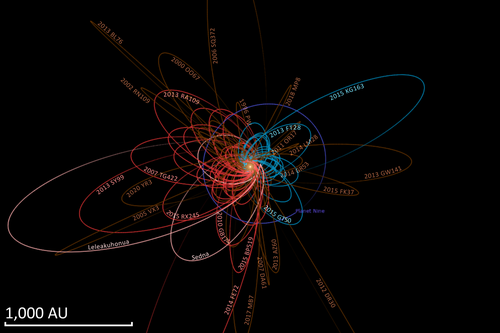(87269) 2000 OO67
| Discovery | |
|---|---|
| Discovered by | Cerro Tololo Obs. |
| Discovery site | Cerro Tololo Obs. |
| Discovery date | 29 July 2000 |
| Designations | |
| 2000 OO67 | |
| TNO[1] · centaur (DES)[2] | |
| Orbital characteristics[1] | |
| Epoch 13 January 2016 (JD 2457400.5) | |
| Uncertainty parameter 2 | |
| Observation arc | 2187 days (5.99 yr) |
| Earliest precovery date | 29 July 2000 |
| Aphelion | 1,041.743 AU (155.8425 Tm) |
| Perihelion | 20.7305754 AU (3.10124994 Tm) |
| 531.2369251 AU (79.47191283 Tm) | |
| Eccentricity | 0.9609768 |
| 11760.29 yr (4295446.2 d) | |
Average orbital speed | 0.88 km/s |
| 0.328967° | |
| 0° 0m 0.302s / day | |
| Inclination | 20.0729° |
| 142.391° | |
| 212.345° | |
| Uranus MOID | 1.82 AU (0.272 Tm)[3] |
| TJupiter | 5.265 |
| Physical characteristics | |
Mean diameter | 64 km (est. at 0.09)[4] |
| Temperature | ~12 K |
| 9.2[1] | |
(87269) 2000 OO67 (provisional designation 2000 OO67) is a trans-Neptunian object, approximately 64 kilometers (40 miles) in diameter, on a highly eccentric orbit in the outermost region of the Solar System. It was discovered by astronomers at the Chilean Cerro Tololo Inter-American Observatory on 29 July 2000.

Description
At aphelion it is over 1,000 AU from the Sun and, with a perihelion of 21 AU, almost crosses the orbit of Uranus at closest approach. Astronomers with the Deep Ecliptic Survey classify it as a centaur rather than a trans-Neptunian object.[2][5] 2000 OO67 came to perihelion in April 2005.[2][1][6] Both 2000 OO67 and 2006 SQ372 are calculated to take longer than Sedna to orbit the Sun using either heliocentric coordinates or barycentric coordinates.
Comparison

See also
- 2002 RN109
- 2005 VX3
- (308933) 2006 SQ372
- 2007 TG422
- TAU (spacecraft) (probe designed to go 1000 AU in 50 years)
- List of Solar System objects by greatest aphelion
References
- ^ a b c d "JPL Small-Body Database Browser: 87269 (2000 OO67)" (2006-07-25 last obs). Retrieved 12 April 2016.
- ^ a b c Marc W. Buie. "Orbit Fit and Astrometric record for 87269" (2006-07-25 using 33 of 34 obs). Deep Ecliptic Survey. Retrieved 2008-05-18.
- ^ "(87269) = 2000 OO67". IAU minor planet center. Archived from the original on 2013-06-26. Retrieved 2017-02-22.
- ^ "Asteroid Size Estimator". CNEOS NASA/JPL. Retrieved 3 March 2020.
- ^ Emel’yanenko, V.V. (2006). "Structure and Dynamics of the Centaur Population: Constraints on the Origin of Short-Period Comets". Earth, Moon, and Planets. 97 (3–4): 341–351. doi:10.1007/s11038-006-9095-5. S2CID 122072238.
- ^ Yeomans, Donald K. "Horizons Online Ephemeris System". California Institute of Technology, Jet Propulsion Laboratory. Retrieved 2008-01-25.
External links
- List Of Centaurs and Scattered-Disk Objects at the Minor Planet Center
- (87269) 2000 OO67 at AstDyS-2, Asteroids—Dynamic Site
- (87269) 2000 OO67 at the JPL Small-Body Database
